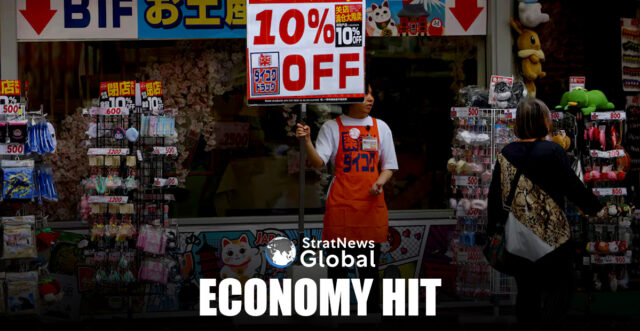Japan’s economy contracted for the first time in a year during the March quarter, declining more sharply than anticipated, according to data released on Friday. The figures highlight the fragility of the country’s recovery, which is now facing new risks from US President Donald Trump’s trade policies.
The data highlights the challenge policymakers face as steep US tariffs cloud the outlook for the export-heavy economy, particularly for the mainstay automobiles sector.
Real gross domestic product (GDP) contracted an annualised 0.7% in January-March, preliminary government data showed, much bigger than a median market forecast for a 0.2% drop. It followed a revised 2.4% increase in the previous quarter.
The decline was due to stagnant private consumption and falling exports, suggesting the economy was losing support from overseas demand even before Trump’s announcement on April 2 of sweeping “reciprocal” tariffs.
‘Lacks A Driver Of Growth’
“Japan’s economy lacks a driver of growth given weakness in exports and consumption. It’s very vulnerable to shocks such as one from Trump tariffs,” said Yoshiki Shinke, senior executive economist at Dai-ichi Life Research Institute.
“The data may lead to growing calls for bigger fiscal spending,” he said, adding the economy could contract again in the second quarter depending on when the hit from tariffs intensifies.
Numbers
On a quarter-on-quarter basis, the economy shrank 0.2% compared with market forecasts for a 0.1% contraction.
Private consumption, which accounts for more than half of Japan’s economic output, was flat in the first quarter, compared with market forecasts for a 0.1% gain.
Capital expenditure increased 1.4% compared with market forecasts for a 0.8% gain, the data showed.
External demand shaved 0.8 percentage point off GDP growth as exports fell 0.6%, while imports rose 2.9%. Domestic demand, by contrast, added 0.7 point to growth.
Economy ‘Will Lack Momentum’
“Capital expenditure rose probably due to front-loading ahead of Trump tariffs. The economy may avert negative growth in April-June, but will lack momentum,” said Takeshi Minami, chief economist at Norinchukin Research Institute.
“If the impact of Trump tariffs is fairly light, the Bank of Japan could raise interest rates again in September or October. But if the tariffs deal a severe blow to capital spending and exports, rate hikes could be put on hold,” he said.
A global trade war touched off by US tariffs has jolted financial markets and complicated the BOJ’s decision on when and how far it can push up interest rates.
Having exited a decade-long stimulus last year, the BOJ hiked rates to 0.5% in January and has signaled its readiness to keep hiking borrowing costs if a moderate economic recovery keeps Japan on track to durably hit its 2% inflation target.
But fears of a Trump-induced global slowdown forced the BOJ to sharply cut its growth forecasts at its April 30-May 1 policy meeting, and cast doubt on its view that sustained wage hikes will underpin consumption and the broader economy.
While a de-escalation of US-China trade tensions offered markets and policymakers some relief, there is uncertainty on whether Japan can win exemptions from US tariffs in bilateral trade talks with Washington.
The gloomy GDP data may also pile pressure on Prime Minister Shigeru Ishiba to heed lawmakers’ demands to cut tax or compile a fresh stimulus package.
(With inputs from Reuters)





